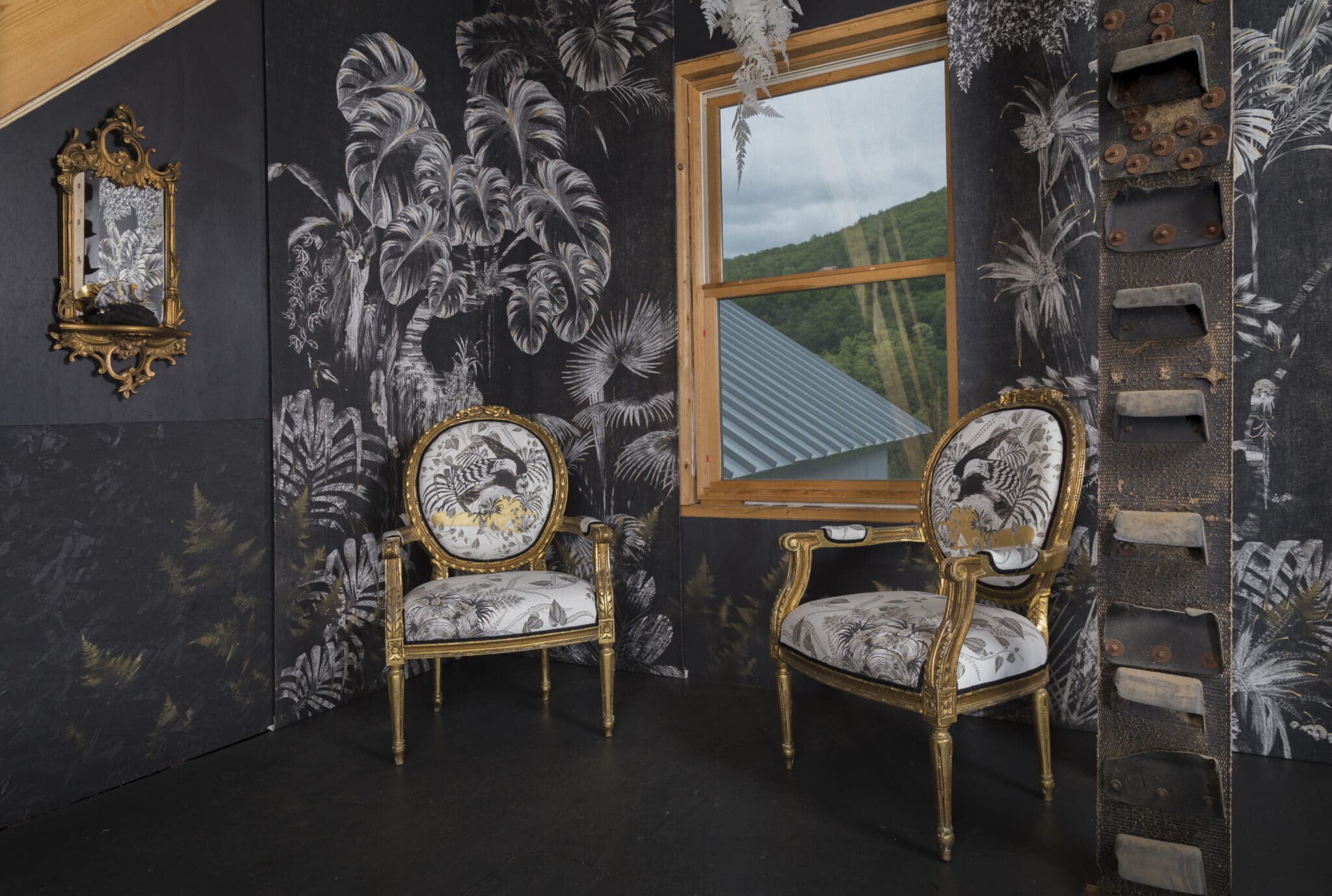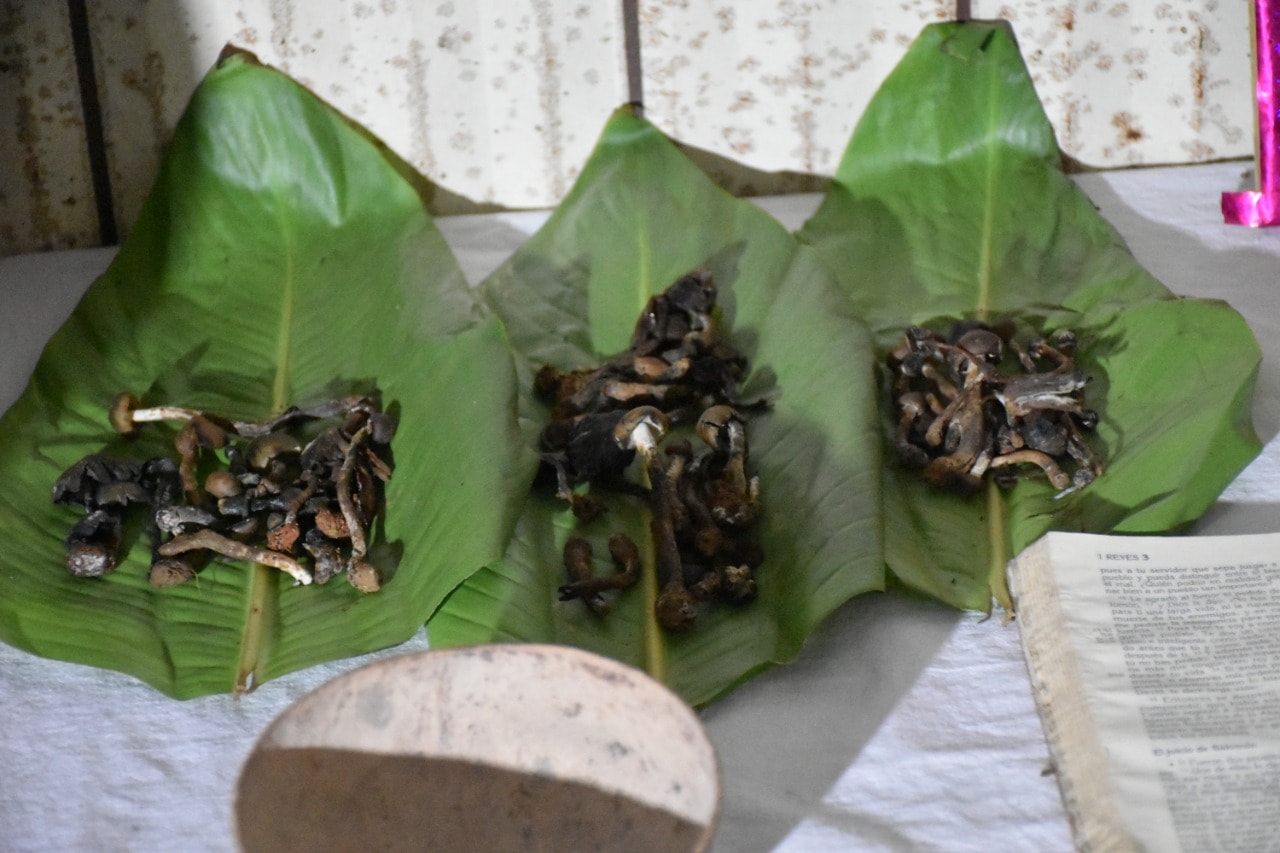
The beauty I found in coca leaves
In Belleza Inminente, Tatiana Arocha explores coca, its uses, and the environments in which it is grown. In her latest project, the U.S.-based Colombian artist brings illustrations and installations, including a space that invites viewers to drink coca tea and talk about illicit crops’ environmental and social impacts.
By Marcela Vallejo
The first time Tatiana Arocha saw a coca bush was in 2018, on a trip to Pucallpa, Peru. It was an unexpected and surprising encounter. Until that moment, for her, coca was something almost fantastic. She took a branch of the plant, pressed it, put it in her luggage, and with great trepidation, took it back to her home in New York. Although she had no problems at the airports, she took more precautions at home: she put the twig in an envelope, put it in a drawer, and forgot it. During the pandemic, she remembered that twig. She took it out, rubbed the leaves between her hands, and that movement triggered many thoughts. For her, it was like a memorable encounter with the plant, which she has repeated ever since. Then, she decided to work more deeply on some ideas she had been building since she came to live in the United States.
Arocha settled in New York in 2000. At that time, she worked as a graphic designer for television and film. One of the things that struck her most about her arrival in the United States was that when she said she was Colombian, people would ask her about cocaine. The questions varied, but they all revolved around that substance. Naturally, that made her uncomfortable. No one knew much about Colombia. But those questions were the initial impetus to think about where she came from and how she understood the problems associated with drug trafficking, the war on drugs, and the coca leaf.
Those reflections happened when she decided to change the focus of her career and start a path as an artist. Then she began a series of works she recreated, using the collage technique, the jungles of Chocó that she had seen on a trip with her father. Her reconstructions are not exact. They are the jungles of his memory, the ones she built with images of others, but above all, they are not virgin jungles: they are landscapes intervened by deforestation.
She wanted to achieve two things: first, to show other images of her country to those who only saw very few aspects of it; second, she wanted them to see that the thing that attracted so much attention, cocaine, had a severe environmental effect. Her current project, Belleza Inminente, is based on that experience.
Mi maestra, mi guía, Coca. Belleza inminente. Foto: Tatiana Arocha.
Beauty in a forbidden plant
For Tatiana, there is a direct connection: a path she has been walking little by little and in which she has been transforming her gaze. In 2017 she began a deeper exploration of the coca leaf. The first public exhibition of this project was the installation of a tea room in the European style of the 19th century. Arocha designed all the elements: the tableware, the furniture, and the table, with symbols alluding to the coca leaf and its cultivation in Colombia. In the installation, she invited people to drink coca tea and talk about the environmental impact of illicit crops and the violence associated with them, but also about the traditional uses of the leaf.
Her curiosity led her down the path of traditional uses. So, thanks to a grant for artists with children, she visited the Colombian Amazon and met Gory Nejedeka, an indigenous Muinane who introduced her to the world of Mambe and Ambil. Mambe is a powder obtained by roasting and crushing coca leaves and then combining it with ash from the leaves of the Yarumo tree. On the other hand, Ambil is a wax obtained by boiling tobacco leaves and mixing them with alkalized salts obtained from other plants. Both substances are used for traditional rituals and medicinal purposes.
On her first visit in 2019, Gory told her that she could not take pictures of the coca nor take leaves. So Tatiana dedicated herself to learning about other aspects of the Muinane culture, such as cultivating and harvesting yucca brava to make cassava. Later, when Tatiana reviewed her photos of the yucca, she realized that she had always been surrounded by coca; but this only happened when Tatiana came across the leaves picked in Peru.
The fear of the prohibition that is so radical in the United States made her very afraid to take out her coca leaves. But this reunion was necessary to continue creating. Although Gory told her that she could not take anything with her, Gory gave her an Ambil, and with that substance, she began to make textures. That is part of her current creative process: Tatiana creates digital images of plants from many photographs and textures she designs, playing with materials such as Ambil and leaves and bark. With them, she makes illustrations and installations.
In Belleza Inminente, Tatiana continues to make jungles, trees, and plants such as coca. She learned along the way that she didn’t want to keep “tidying up the jungle.” “That’s something National Geographic does,” she says, “show a perfect, ordered jungle, with the animals in the right place at the right time.” She knows that the jungle does not respond to those orders; it is chaotic and makes sense in its chaos. Now, she is not interested in organizing but in showing all those stimuli to which she is exposed when she goes to a forest.
In her work, she seeks the relationship between plants and territories that allow her to maintain a dialogue with coca and to sustain ideas that she has been building for several years: that the United States must start a conversation about the effects of prohibition. At the moment, one of these effects is that Tatiana works without coca since she does not have direct access to the plants or their derivatives. But also, this prohibition has natural consequences in her country: even though there are communities that traditionally consume coca leaves, it is stigmatized.
The project’s name has to do with a search that escapes the extremes from which these plants are commonly thought of: good or evil. Although she was not living in Colombia at the time it happened, she had very much in mind that campaign of the Colombian state that branded plants such as coca or marijuana as “plants that kill.” A slogan that the Constitutional Court declared as a message that stigmatizes not only the plant but also indigenous and peasant communities that consume it traditionally. However, it was not so easily forgotten.
This project is very representative of the artist’s personal quest: to make a place for herself in the United States, a country where she is a foreigner, through an encounter with coca, a plant that has gone through the history of Colombia, the country she considers her own even though she does not live there. In that sense, Belleza Inminente has to do with beauty at a middle point,” says Tatiana, “where I see beauty in something that supposedly is not beautiful.”


